10 Best Brewing Pumps for Perfect Beer Every Time
I’ve tested dozens of brewing pumps and found that the best models feature 304 stainless steel construction, handle temperatures up to 248°F, and deliver 5-7 GPM flow rates for ideal wort transfer. Top performers include magnetic drive pumps with quick disconnects, auto-siphon kits for gravity transfers, and high-temp models with anti-vibration designs. Remember, these pumps aren’t self-priming and need installation 12 inches below your brewing vessel. The right pump selection depends on your specific brewing setup and batch size requirements.
We are supported by our audience. When you purchase through links on our site, we may earn an affiliate commission, at no extra cost for you. Learn more. Last update on 24th December 2025 / Images from Amazon Product Advertising API.
Notable Insights
- High-temperature wort pumps with 304 stainless steel construction handle temperatures up to 248°F for safe brewing transfers.
- Optimal flow rates of 5-7 GPM for small to medium batches ensure efficient liquid transfer without compromising quality.
- Magnetic drive designs provide quiet operation and reduced friction while maintaining durability for consistent brewing performance.
- Food-grade materials and proper sealing mechanisms prevent contamination and maintain beer flavor integrity throughout the brewing process.
- Installation requires positioning 12 inches below brewing vessels with manual priming for reliable, non-self-priming pump operation.
Fermtech Mini 14 Long Deluxe Siphoning Kit for Home Brewing

Home brewers who want hassle-free transfers without mouth suction will find the Fermtech Mini 14 Long Deluxe Siphoning Kit their ideal solution. This complete kit includes an auto siphon pump, food-grade transfer hose, and bottling wand for beer, wine, and mead production. You’ll start liquid flow with just one stroke, eliminating contamination risks while maintaining efficiency. The 14-inch siphoning tube minimizes oxidation during transfers, and the food-grade materials guarantee clean, secure transfers without leaks. With a 4.6-star rating from over 1,400 users, this kit excels at sediment removal and works perfectly for small-batch brewing projects.
Best For: Home brewers of all experience levels who want efficient, contamination-free liquid transfers for small-batch beer, wine, and mead production without the hassle of mouth suction.
Pros:
- Auto siphon starts with single stroke, eliminating mouth suction and contamination risks
- Food-grade materials with secure-fit design prevent leaks and ensure clean transfers
- 14-inch tube minimizes oxidation and effectively removes sediment during bottling
Cons:
- Some users report difficulty with cleaning despite included cleaning tool
- Designed primarily for small-batch projects, may not suit large-scale brewing
- Initial setup may require practice for optimal sediment removal technique
Auto Siphon Mini with 6 Ft Food Safe Tubing for Home Brewing & Winemaking

Small-batch brewers and winemakers will find the Auto Siphon Mini with 6 Ft Food Safe Tubing perfectly suited for their craft. At 14 inches long, it fits openings as small as 1 inch, making it perfect for transferring beer, wine, kombucha, and homemade infusions. You’ll appreciate the single-pump operation that creates consistent flow while minimizing spills and waste. The kit includes a durable siphon wand, 6 feet of food-safe tubing, and a secure clip for stability during transfers. While users praise its ease of use and reliability, some mention cleaning can be challenging (though the results make it worthwhile).
Best For: Small-batch brewers, winemakers, and hobbyists who need to transfer beer, wine, kombucha, and homemade infusions from containers with small openings.
Pros:
- Single-pump operation creates consistent flow while minimizing spills and waste
- Compact 14-inch design fits openings as small as 1 inch, perfect for small-batch projects
- Complete kit includes durable siphon wand, 6 feet of food-safe tubing, and secure clip for stability
Cons:
- Cleaning can be challenging according to user feedback
- Some users report difficulty with clamping during use
- Mixed feedback on long-term durability despite high-quality construction claims
Wort Pump for Brewing, Food Grade Homebrew Magnetic Beer Pump

Brewing enthusiasts who demand precision temperature control will find the Wort Pump for Brewing delivers exceptional performance with its 304 stainless steel construction and ability to handle liquids up to 120°C (248°F). You’ll appreciate the magnetic drive design that reduces noise and friction while maintaining efficient operation. The pump requires installation at least 12 inches below your liquid container since it’s not self-priming. You must fill the inlet hose and pump body with liquid before starting to prevent air lock issues. The 1/2 NPT male threaded head and quick disconnect fittings guarantee secure connections, while the 4.75-foot power cord provides installation flexibility for your brewing setup.
Best For: Serious homebrewers who need precise temperature control and efficient wort transfer capabilities for advanced brewing processes.
Pros:
- High-temperature capability up to 120°C (248°F) with durable 304 stainless steel construction
- Quiet magnetic drive design reduces noise and friction while maintaining efficient performance
- Secure connection system with threaded quick disconnect and flexible 4.75-foot power cord
Cons:
- Not self-priming, requiring installation at least 12 inches below liquid container
- Requires manual filling of inlet hose and pump body before operation to prevent air lock
- Limited to inline applications due to specific installation height requirements
Fermtech Auto Siphon Kit for Home Brewing Beer & Wine

Craft enthusiasts who want reliable, spill-free transfers will find the Fermtech Auto Siphon Kit perfectly suited for their beer, wine, and mead projects. This 1/2″ large auto siphon features a one-pump start system that eliminates tedious manual priming. You’ll appreciate the triple-scale design, which creates strong flow while minimizing sediment transfer into your final product.
The complete kit includes food-grade plastic components: the auto siphon, flexible hose, and bottling wand. You can fill bottles precisely with the included wand, preventing overflow and reducing waste during your bottling sessions. The food-grade materials maintain your beverage’s purity by preventing contamination and off-flavors from affecting taste.
Best For: Home brewing enthusiasts and craft beverage makers who want an efficient, reliable siphoning system for transferring and bottling beer, wine, and mead with minimal sediment disturbance.
Pros:
- One-pump start system eliminates tedious manual priming and makes siphoning quick and effortless
- Triple-scale design creates strong flow while minimizing sediment transfer for cleaner final products
- Complete kit with food-grade components including auto siphon, hose, and bottling wand for precise filling
Cons:
- Limited to 1/2″ size which may not be optimal for all batch sizes or transfer speed preferences
- Plastic construction may be less durable than metal alternatives for heavy-use brewing operations
- Requires proper cleaning and sanitization between uses to maintain food-grade safety standards
Wort Pump High Temp Brewing Pump with Magnetic Drive and Quick Disconnects
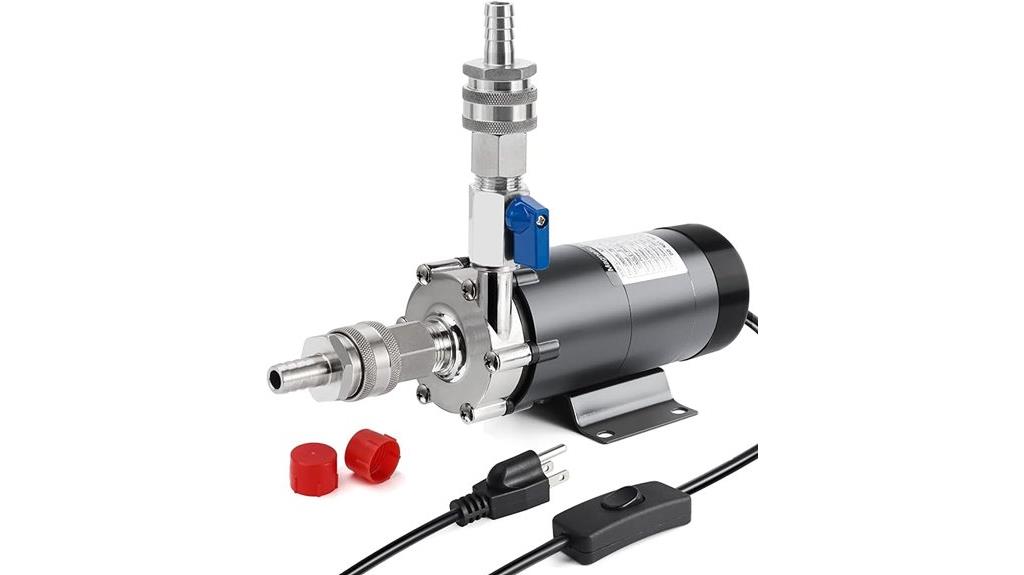
Temperature extremes pose one of the biggest challenges for homebrewers transferring hot wort and recirculating mash liquids. The Hilangsan Wort Pump handles temperatures up to 248℉, making it ideal for these demanding applications. You’ll appreciate its 304 stainless steel construction and magnetic drive system, which operates quietly while eliminating friction losses. The quick disconnects let you switch hoses easily without complex installations, while the mini ball valve controls flow rates precisely. At 5.65 pounds, it’s built for durability with a fully sealed design that prevents leaks. Customer reviews praise its power and premium features, though some note occasional clogging with dense worts.
Best For: Homebrewers who need to transfer hot wort and recirculate mash liquids at high temperatures while maintaining quiet operation and precise flow control.
Pros:
- Handles extreme temperatures up to 248℉ with durable 304 stainless steel construction
- Magnetic drive system operates quietly while eliminating friction losses and preventing leaks
- Quick disconnects and mini ball valve provide easy hose switching and precise flow rate control
Cons:
- Can experience clogging issues when working with denser worts
- May have difficulties with self-priming during operation
- Limited customer feedback available since it’s relatively new to market (launched February 2023)
FERRODAY Wort Brewing Pump, Stainless Head Magnetic Drive for Homebrew Beer
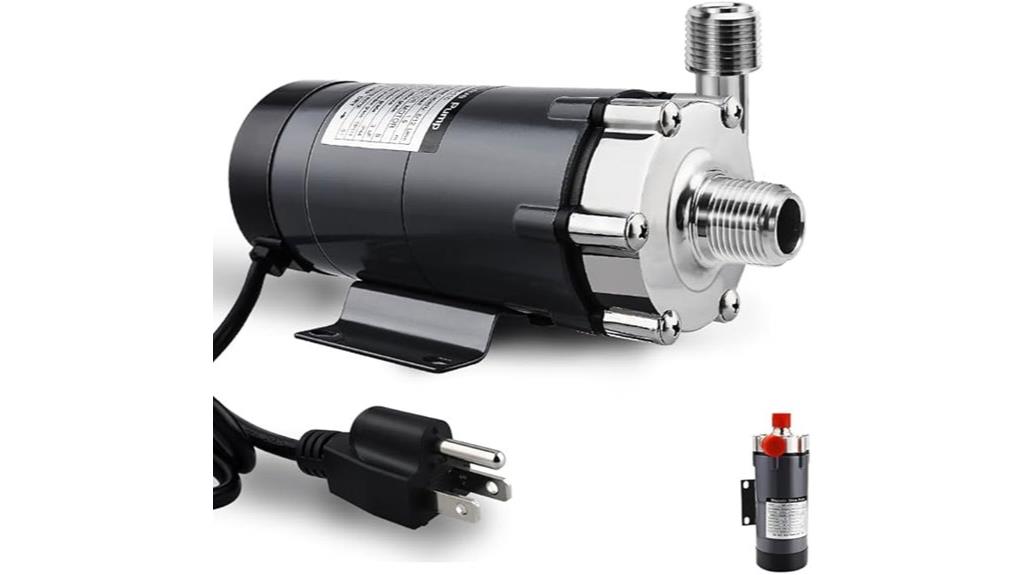
Homebrewers seeking reliable liquid transfer during their beer-making process will find the FERRODAY Wort Brewing Pump delivers consistent performance with its stainless steel magnetic drive system. This 4.58-pound pump handles up to 5 gallons per minute and withstands temperatures reaching 248℉, making it suitable for hot wort transfers. You’ll need to install it 12 inches below your brewing vessel since it’s not self-priming. Fill the pump with liquid before powering on to guarantee proper operation. The anti-vibration design keeps noise levels low during use. Limit continuous operation to 2 hours to prevent motor overheating and maintain peak performance.
Best For: Homebrewers who need a reliable, heat-resistant pump for transferring hot wort and other brewing liquids with consistent flow rates up to 5 gallons per minute.
Pros:
- High temperature resistance up to 248℉ makes it ideal for hot wort transfers during brewing
- Quiet operation with anti-vibration design reduces noise and motor vibration during use
- Strong flow rate of 5 gallons per minute with good lifting capacity up to 2.7 meters
Cons:
- Not self-priming and requires installation 12 inches below the brewing vessel for proper operation
- Limited to 2 hours of continuous operation to prevent motor overheating
- Not suitable for high viscosity liquids, limiting its versatility for other applications
RIPTIDE BREWING PUMP by Blichmann Engineering With Integrated Valve
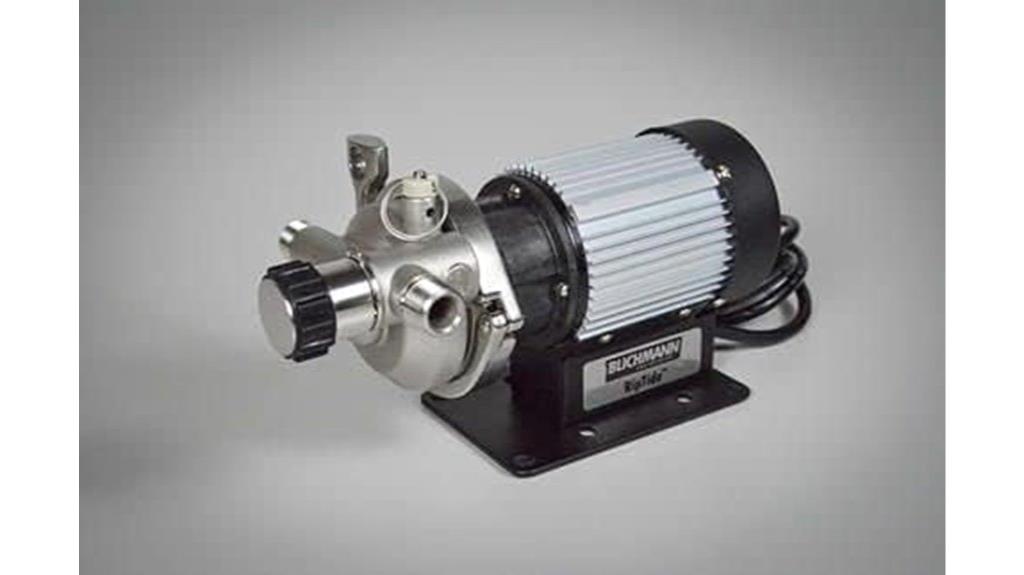
The RIPTIDE BREWING PUMP from Blichmann Engineering delivers professional-grade performance that makes it ideal for serious brewers who demand reliable fluid transfer throughout their brewing process. You’ll get 7 GPM flow rate with a maximum pressure head of 21 feet, powered by strong rare earth magnets and a high-performance curved blade impeller. The tri-clamp head connection lets you disassemble and clean components easily, while the stainless steel head rotates 360 degrees for flexible installation options. You’ll connect through 1/2 NPT inlet and outlet fittings, and the 10-foot cord plugs into standard 120V outlets for convenient operation.
Best For: Serious home brewers and small commercial brewing operations who need reliable, high-performance fluid transfer with easy cleaning and flexible installation options.
Pros:
- High flow rate of 7 GPM with 21 ft maximum pressure head provides excellent performance for brewing applications
- Tri-clamp head connection and 360-degree rotating stainless steel head offer easy disassembly, cleaning, and flexible installation
- Strong rare earth magnets and curved blade impeller design ensure reliable, efficient operation
Cons:
- Higher price point compared to basic brewing pumps may not fit all budgets
- 1/2 NPT connections may require additional fittings or adapters for some brewing setups
- 120V power requirement limits portability for outdoor or remote brewing locations without standard electrical access
Wort Pump for Brewing, Food Grade Homebrew Magnetic Beer Pump
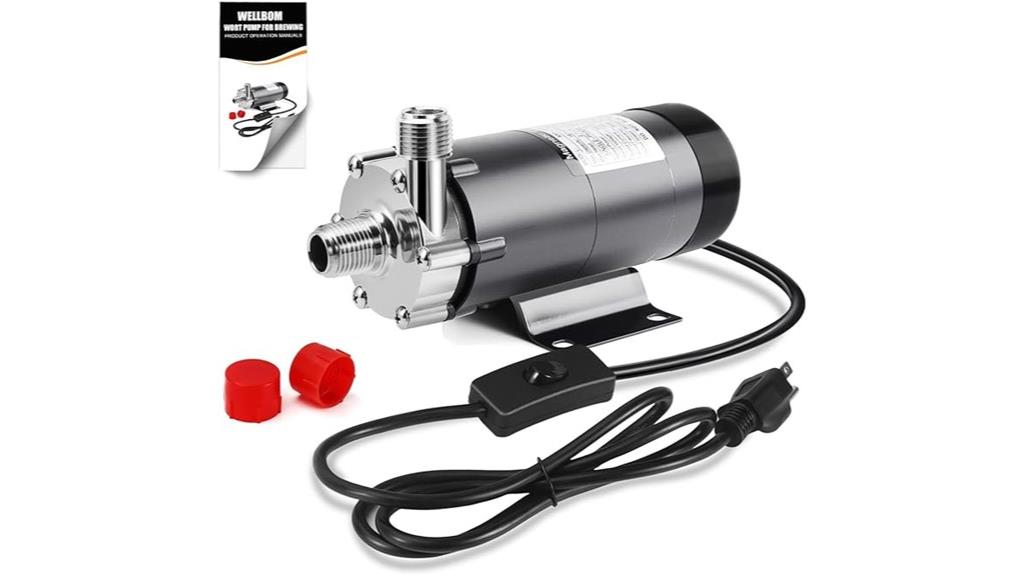
Food-grade construction and high-temperature capability make this magnetic wort pump an essential tool for serious homebrewers who demand efficiency and safety in their brewing process. This 304 stainless steel pump handles liquids up to 248°F, making it perfect for hot wort transfers. You’ll need to position it at least 12 inches below your liquid container since it’s not self-priming. The magnetic drive design operates quietly while reducing friction loss, and the included inline switch provides convenient control. With its 1/2 NPT threaded connection and quick disconnect feature, you’ll achieve efficient recirculation and cooling for enhanced brewing results.
Best For: Serious homebrewers who need a reliable, food-grade pump for hot wort transfers and recirculation in their brewing setup.
Pros:
- Food-grade 304 stainless steel construction handles high temperatures up to 248°F safely
- Quiet magnetic drive design reduces noise and friction loss during operation
- Convenient inline switch and quick disconnect fittings for easy control and connections
Cons:
- Not self-priming, requiring positioning at least 12 inches below liquid container
- Must be filled with liquid before operation to prevent air lock issues
- Limited to non-self-priming applications which may restrict installation flexibility
Wort Pump Food Grade Pump for Homebrew (Grey)
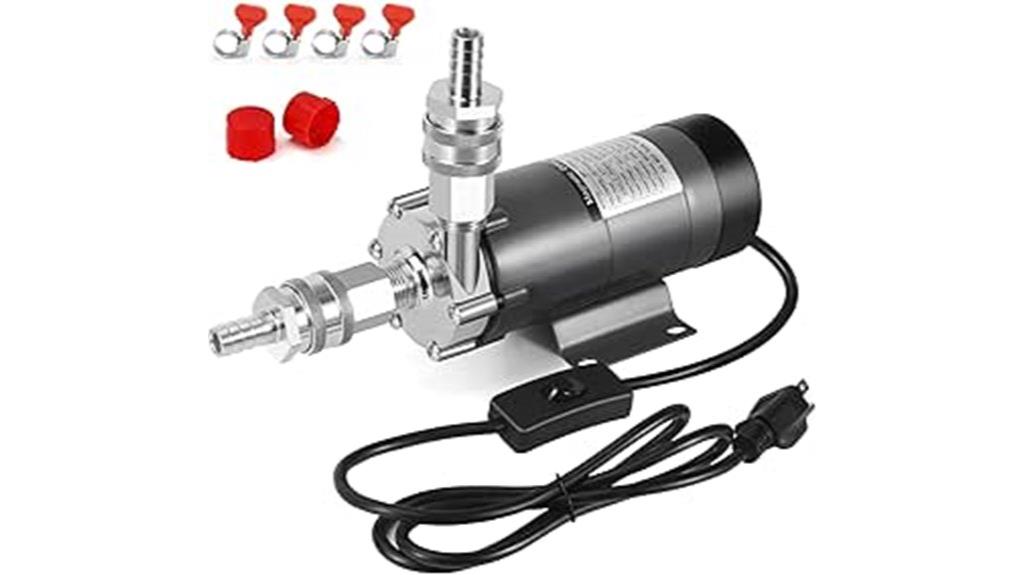
Magnetic drive technology sets this food-grade wort pump apart as the ideal choice for homebrewers who demand leak-free operation and whisper-quiet performance. You’ll appreciate its 304 stainless steel construction and food-grade ABS impeller, which resist corrosion while handling temperatures up to 248℉. The compact design weighs just 5.38 pounds, making it perfect for home brewing setups.
You can control flow precisely using the mini ball valve, while beer line clamps prevent unwanted leakage during transfers. The included safety switch and 1/2 barb brewing quick disconnect simplify connections and enhance operational safety. This pump’s magnetic drive eliminates the noise issues common with traditional pumps, creating a more pleasant brewing environment.
Best For: Homebrewers who need a reliable, quiet, and leak-free pump for transferring wort and beer at high temperatures with precise flow control.
Pros:
- Magnetic drive technology ensures completely leak-free and whisper-quiet operation
- High-temperature resistance up to 248℉ with durable 304 stainless steel construction
- Compact 5.38-pound design with precise flow control via mini ball valve and safety features
Cons:
- Limited to smaller homebrew operations due to compact size
- Higher price point compared to basic transfer pumps
- Relatively new product with limited long-term user reviews (only 5 ratings)
110V Magnetic Home Brewing System Beer Pump (Stainless Steel Head)
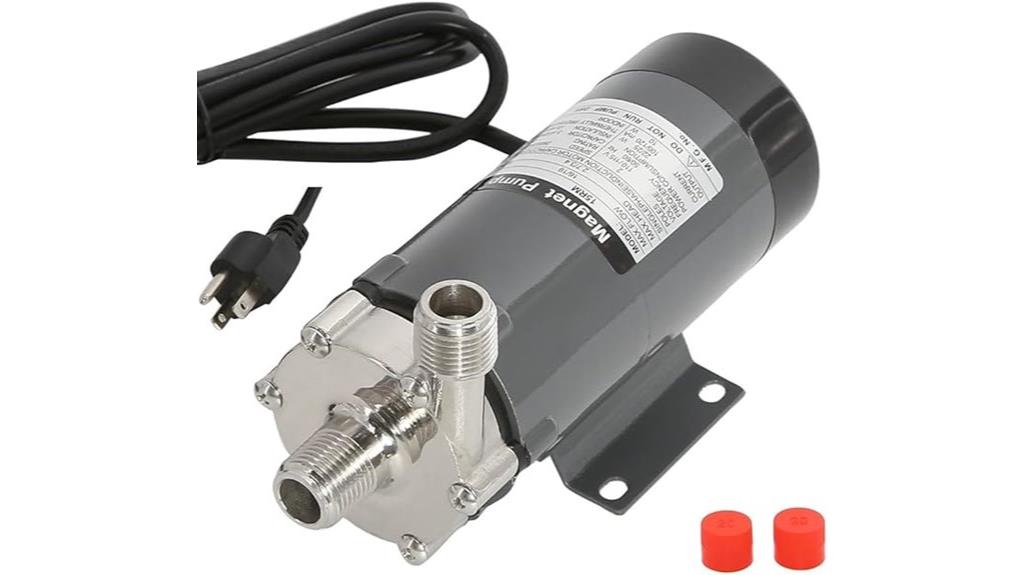
Home brewers seeking reliable liquid transfer capabilities will find the YaeKoo 110V Magnetic Beer Pump delivers consistent performance with its food-grade 304 stainless steel construction. This compact 4-pound unit operates at just 10 watts while providing 19 LPM flow rates and 10-foot lifting height. You’ll appreciate the quiet magnetic drive system that separates the main shaft from the impeller, reducing vibration and noise during operation. The closed static seal design prevents leakage and simplifies priming—just run liquid through before starting. Its 1/2-inch inlet/outlet connections handle multiple brewing tasks, from mash recirculation to kettle transfers, making it versatile for various homebrew applications.
Best For: Home brewers who need a reliable, quiet pump for transferring liquids during various brewing processes like mash recirculation, wort transfers, and kettle-to-kettle operations.
Pros:
- Food-grade 304 stainless steel construction ensures safe, corrosion-resistant operation for brewing applications
- Quiet magnetic drive system with anti-vibration features minimizes noise during operation
- Low 10-watt power consumption while delivering strong 19 LPM flow rate and 10-foot lifting capacity
Cons:
- Requires manual priming by running liquid through the pump before each use
- Limited to 1/2-inch inlet/outlet connections which may not fit all brewing setups
- Moderate customer rating of 4.1/5 stars suggests some users may experience performance issues
Factors to Consider When Choosing Brewing Pumps
When I’m selecting a brewing pump for my beer production, I need to evaluate several critical factors that’ll determine whether the pump meets my specific brewing requirements. The pump type, flow rate capacity, temperature resistance, material construction, and power efficiency all play essential roles in ensuring reliable performance throughout my brewing process. I’ll examine each of these factors to help you make an informed decision that matches your brewing setup and production goals.
Pump Type Selection
Five critical factors will determine whether your brewing pump performs reliably or becomes a costly mistake. First, I recommend magnetic drive pumps for their whisper-quiet operation and reduced leak risk, while self-priming models excel when you need easy liquid transfer without pre-filling. Temperature capacity matters notably – high-temp brewing pumps handle liquids up to 120°C (248°F), which you’ll need for safe wort transfers. Flow rate specifications range from 5 GPM to much higher rates, directly affecting your brewing efficiency. Look for maintenance-friendly features like quick disconnects or tri-clamp heads that simplify cleaning and disassembly. Finally, consider noise levels carefully, as magnetic drive designs typically operate much quieter than alternatives, creating a better brewing environment.
Flow Rate Requirements
Flow rate calculations directly impact your brewing schedule and equipment performance, making proper sizing one of your most essential pump decisions. I recommend choosing pumps with flow rates between 5-7 GPM for most home brewing operations, as this range handles small to medium batches efficiently.
You’ll need to take into account your pump’s maximum lifting height since higher lifts reduce flow rates considerably. Temperature specifications matter too – high-temperature pumps maintain their rated flow rates up to 248°F, which is vital for hot liquor transfers and cleaning cycles.
Matching your pump’s flow rate to your specific brewing needs prevents equipment damage and inefficiencies. A pump that’s too powerful can create excessive turbulence, while an underpowered pump extends your brewing day unnecessarily.
Temperature Resistance Capabilities
Since brewing involves transferring liquids at temperatures reaching 248°F (120°C), your pump’s temperature resistance capabilities become a critical safety and performance factor. I recommend selecting pumps that exceed your maximum brewing temperatures to prevent equipment failure during hot wort transfers or mash recirculation.
Most quality brewing pumps feature 304 stainless steel construction with food-grade components that maintain performance under extreme heat. These materials resist corrosion while handling elevated temperatures safely. When recirculating hot mash or transferring boiling wort, insufficient temperature resistance leads to pump damage, operational downtime, and potential safety hazards.
I suggest choosing pumps rated above your actual brewing temperatures as a safety margin. This approach guarantees reliable operation during intensive brewing sessions and extends your equipment’s lifespan considerably.
Material Quality Standards
When selecting brewing pumps, material quality standards directly impact both your beer’s safety and flavor integrity. I recommend choosing pumps constructed from 304 stainless steel, which provides food-grade safety and prevents contamination during liquid transfers. This material offers excellent corrosion resistance, helping your pump withstand harsh brewing conditions while maintaining durability over time.
You’ll want pumps that handle temperatures up to 120°C (248°F) for efficient hot wort processing. Non-toxic, environmentally friendly materials reduce unwanted flavor contamination and health risks in your finished beer. Pay attention to sealing mechanisms—proper seals prevent leakage and enable effective priming, ensuring reliable operation throughout your brewing process. Quality materials protect both your investment and your beer’s final taste profile.
Power and Efficiency
Power efficiency determines how effectively your brewing pump transfers liquids while minimizing energy consumption and operational costs. I recommend looking for pumps with flow rates around 5 gallons per minute, which maintain smooth operations during your brewing process. Higher lifting heights of 10 feet or more prove beneficial when you’re moving liquids between multiple vessels in your system.
Magnetic drive technology greatly enhances efficiency by minimizing noise and friction loss. You’ll appreciate the quieter operation while reducing wear on pump components. Temperature capability matters too – look for pumps handling up to 248°F (120°C) for safely transferring hot liquids without compromising integrity. Closed static seal designs prevent leakage, ensuring consistent flow rates and reducing spillage during operation.
Installation and Setup
Proper installation sets the foundation for reliable pump performance throughout your brewing operations. I recommend positioning your pump at least 12 inches below your liquid container to prevent air lock issues, since most brewing pumps aren’t self-priming. You’ll want to install quick disconnect fittings on all hose connections – they’ll save you significant setup time when switching between different brewing processes.
Before operating your pump, follow the manufacturer’s priming instructions carefully to avoid damage and guarantee peak performance. Check that your electrical setup matches the pump’s power requirements to prevent operational problems. Finally, confirm your installation location provides easy access for cleaning and troubleshooting. Trust me, cramped spaces make maintenance unnecessarily difficult when you’re dealing with sticky wort residue.
Maintenance and Cleaning
Once you’ve got your pump properly installed, maintaining it becomes your next priority for consistent brewing success. I recommend establishing a cleaning routine after each use to prevent sediment buildup and contamination. Choose pumps with dismountable components since they’re much easier to clean thoroughly than sealed units.
Always prime your pump with liquid before operation to prevent damage and guarantee smooth transfers. Food-grade materials resist corrosion and sanitize safely, making your cleaning process more effective. I suggest using brewery-approved sanitizers and following manufacturer guidelines for disassembly.
Regular maintenance includes checking seals, gaskets, and moving parts for wear. Clean all surfaces that contact beer, paying special attention to crevices where bacteria might hide. This routine prevents off-flavors and extends your pump’s lifespan considerably.
Frequently Asked Questions
How Often Should I Clean and Sanitize My Brewing Pump?
I recommend cleaning your brewing pump after every single use to prevent beer residue buildup and contamination. Rinse it immediately with hot water, then disassemble removable parts for thorough cleaning with brewery wash. Sanitize all components with no-rinse sanitizer before your next brew session. This routine takes just ten minutes but prevents off-flavors and extends your pump’s lifespan greatly.
Can Brewing Pumps Handle Hot Wort Temperatures Above 200°F Safely?
Most brewing pumps can’t handle temperatures above 200°F safely. I recommend checking your pump’s maximum temperature rating, which typically ranges from 140°F to 180°F for standard models. High-temperature pumps designed for brewing can handle up to 212°F, but they’re more expensive. If you’re transferring boiling wort, let it cool to 180°F first, or invest in a pump specifically rated for high-temperature applications.
Do I Need a Brewing Pump for Small 1-Gallon Homebrew Batches?
For 1-gallon batches, I don’t think you need a brewing pump. You can easily lift and pour small volumes by hand during transfers. A pump becomes valuable when you’re handling 5+ gallon batches that weigh 40+ pounds when full. At 1-gallon scale, gravity transfers and manual pouring work perfectly fine and save you money for other brewing equipment upgrades.
Can Brewing Pumps Be Used for Transferring Finished Beer to Kegs?
I recommend using brewing pumps for transferring finished beer to kegs. They’ll move your beer gently while minimizing oxidation exposure compared to siphoning or gravity transfers. Set your pump flow rate between 1-2 gallons per minute to avoid creating excessive foam. Make sure you’ve sanitized all pump components and tubing beforehand. The controlled transfer helps preserve your beer’s flavor and carbonation levels during kegging.
On a final note
I’ve covered the top brewing pumps that’ll transform your homebrewing experience. Whether you choose a simple siphon kit or invest in a magnetic wort pump, you’ll achieve consistent results every batch. Remember to prioritize food-grade materials, proper flow rates, and temperature resistance when making your decision. Your brewing process will become more efficient, and you’ll produce better beer with less effort using the right pump.
